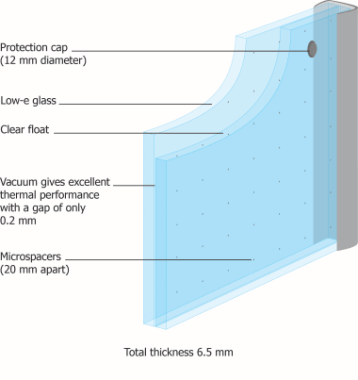Vacuum insulated glass (VIG) is an insulated glass with a vacuum layer between two rigidly held panes of glass to maximize thermal efficiency and sound insulation. VIG is a thermally insulating window technology that outperforms existing insulating glass (IG) technologies.
Image Credits: Traditional Building Magazine
VIG technology aims at meeting the thermal performance requirements of net-zero energy windows.
This article discusses the working and benefits of vacuum insulated glass technology (VIG) in the construction industry.
Vacuum Insulated Glass (VIG) Technology
A VIG consists of two panes of glass enclosing a thin layer of vacuum space. Generally, the space is about a tenth of a millimeter wide with a pressure of 0.1 Pa or less. Unlike other insulating technologies, VIG encloses nothing but vacuum between the glass panes. Hence, there are no air or gas molecules to transfer heat between panes.
Image Credits: Morn
Features of Vacuum Insulated Glass (VIG)
- VIG is a deep-processed high-performance glass formed by two pieces of glass with a vacuum layer in between them. One is white glass, and the other is a LOW-E glass. The two glass panes are fused, sealed, and held together to form a vacuum layer with a thickness of 0.1 to 0.2 mm.
- The vacuum layer in VIG does not have any air or gaseous medium. Hence, unlike other IG types, there is no direct conduction or convection medium. This principle improves the thermal resistance of vacuum glass.
- The sealing technology used in the manufacture of VIGis highly efficient and durable, maintaining the performance of vacuum glass for a longer period.
- The vacuum glass unit is super light and thin, which helps decrease loads on the buildings. It reduces the use of frame materials, especially aluminum or PVC profiles, which helps in reducing construction costs.
- The vacuum technology in a VIG unit decreases the U value to 0.5 or less.
- Vacuum glass has a thermal insulation performance four times higher than an insulating glass and six times greater than that of a single-layer glass. A normal VIG would provide a thermal performance equivalent to a 370 mm concrete wall.
- Due to the existence of vacuum in VIG, sound transmission is blocked. Hence, its sound insulation performance is about 10 dB higher than that of normal insulating glass.
- VIG unit is extremely airtight, with no water vapor molecules. Their unique arrangement eliminates condensation in winter.
- The overall thickness of the VIG unit is smaller compared to other window glass types. Hence, it is easier to design windows, especially for replacement works.
- Based on the project requirements, VIG is manufactured in custom sizes.
- VIG improves the acoustic insulation and thermal insulation of the property. It positively influences the energy consumption of the building, which will increase the value of the property.
- It is used in hospitals, laboratories, and the renovation of doors and windows as an energy-saving option.
- VIG is not cheap due to the limited number of manufacturers. But compared to their long-term performance and efficiency, they are worth the cost.
FAQs
Vacuum insulated glass (VIG) is an insulated glass with a vacuum layer between two rigidly held panes of glass to maximize thermal efficiency and sound insulation.
A VIG consists of two panes of glass enclosing a thin layer of vacuum space. Generally, the space is about a tenth of a millimeter wide with a pressure of 0.1 Pa or less. Unlike other insulating technologies, VIG encloses nothing but vacuum between the glass panes. Hence, there are no air or gas molecules to transfer heat between panes.
VIG improves the acoustic insulation and thermal insulation of the property. It positively influences the energy consumption of the building, which will increase the value of the property.
Read More
Basic Principles to Achieve Net-Zero Energy Buildings (NZEB)
